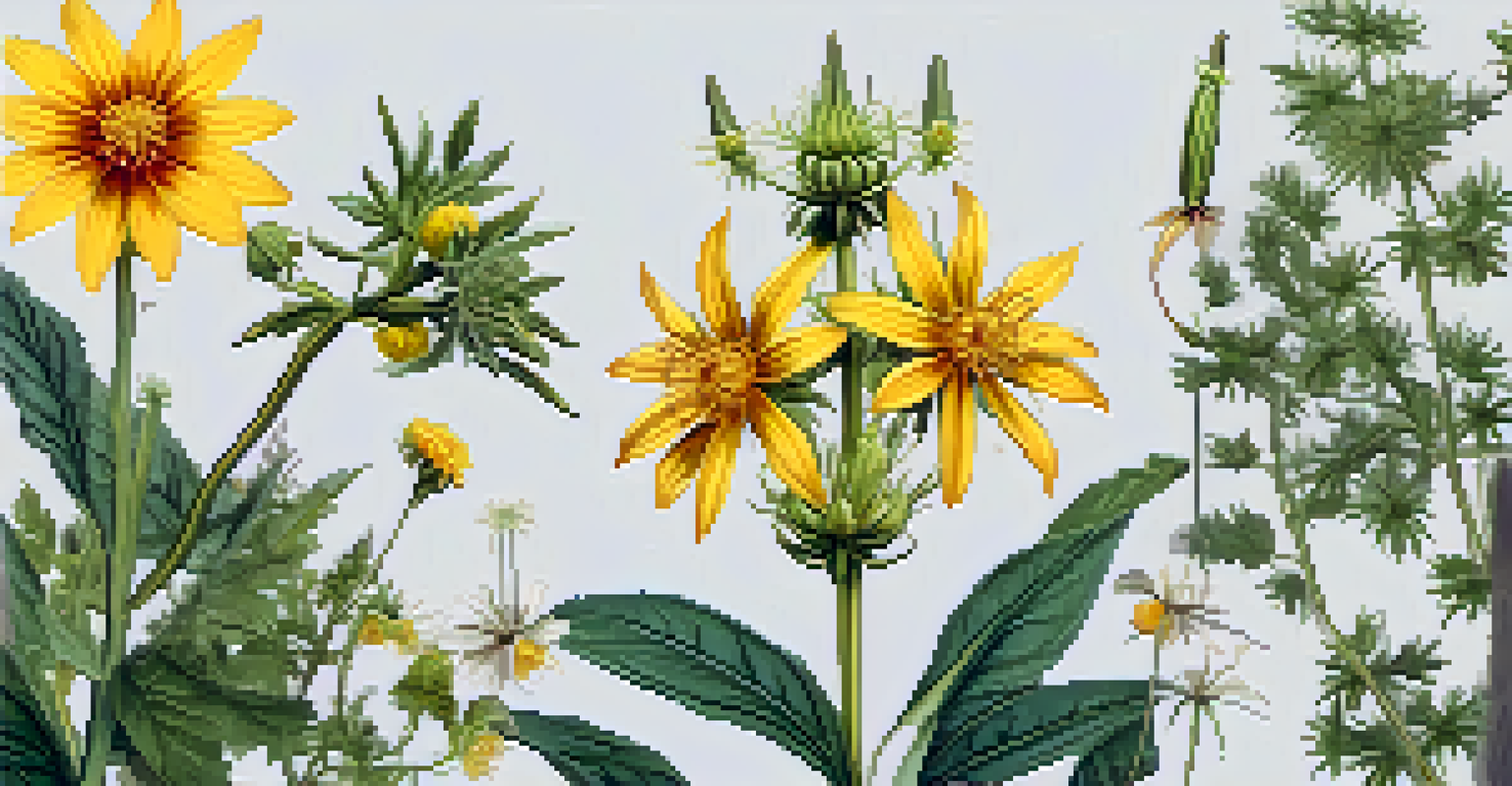The Role of Medicinal Plants in Homeopathy Today

Understanding Homeopathy and Its Foundations
Homeopathy is a holistic healing system based on the principle of 'like cures like.' It uses highly diluted substances to stimulate the body's healing response. This approach contrasts with conventional medicine, which often focuses on symptom suppression. By understanding the core principles of homeopathy, we can appreciate how medicinal plants play a vital role in this practice.
Nature itself is the best physician.
The historical roots of homeopathy trace back to the late 18th century, when Samuel Hahnemann introduced the concept. He believed that nature provided remedies for ailments, and many of these were derived from plants. This foundation set the stage for the incorporation of various botanical elements into homeopathic remedies that we still see today.
In essence, homeopathy values the innate healing abilities of the body, and medicinal plants serve as a key ingredient in enhancing that process. Their natural properties offer a gentle, yet effective means of treatment, making them a beloved choice for many seeking alternative health solutions.
The Power of Medicinal Plants in Healing
Medicinal plants have been used for centuries across various cultures for their therapeutic properties. They contain active compounds that can help alleviate symptoms and promote overall wellness. For instance, echinacea is famous for its immune-boosting abilities, while chamomile is often used for its calming effects.

In homeopathy, these plants are not just used in their raw form; rather, they are prepared through a meticulous process of dilution and succussion (vigorous shaking). This process enhances their healing properties while ensuring they are safe for consumption. Therefore, the power of these plants is transformed into potent remedies that can address a wide range of health issues.
Homeopathy's Holistic Approach
Homeopathy emphasizes the body's innate healing abilities, often utilizing medicinal plants to enhance this process.
The versatility of medicinal plants is one of the reasons they are so revered in homeopathy. From treating common colds to addressing chronic conditions, these natural remedies offer a holistic approach to health, emphasizing the interconnectedness of mind and body.
Popular Medicinal Plants Used in Homeopathy
There are several medicinal plants that have become staples in homeopathic practice. For example, arnica montana is commonly used for bruising and muscle pain, while belladonna is utilized for fevers and inflammation. These plants have been extensively studied and are recognized for their effectiveness in various conditions.
The greatest medicine of all is to teach people how not to need it.
Another popular choice is St. John's Wort, often recommended for its antidepressant properties. Its inclusion in homeopathic remedies highlights the growing acceptance of plant-based treatments in mental health care. Such examples showcase how medicinal plants provide targeted solutions to specific ailments.
The choice of plant in a homeopathic remedy often depends on the individual’s unique symptoms and overall constitution. This personalized approach is at the heart of homeopathy, allowing practitioners to tailor treatments to best suit their patients' needs.
The Science Behind Medicinal Plants and Homeopathy
While homeopathy has its roots in tradition and holistic philosophy, modern research is beginning to shed light on the scientific basis of medicinal plants. Studies have shown that many plant compounds possess pharmacological properties that can support health. This growing body of evidence is helping to bridge the gap between traditional practices and modern medicine.
For instance, the anti-inflammatory effects of certain herbs have been documented in scientific literature, supporting their use in homeopathic treatments. Understanding these mechanisms can enhance the credibility of homeopathic remedies and encourage more individuals to explore plant-based solutions.
Medicinal Plants in Homeopathy
Various medicinal plants, such as arnica and St. John's Wort, play a crucial role in homeopathic treatments for a range of ailments.
Additionally, the integration of biology and chemistry into homeopathy can foster innovation in developing new treatments. By harnessing the power of medicinal plants through scientific inquiry, practitioners can enhance the efficacy of homeopathic solutions tailored to contemporary health challenges.
Challenges Facing Medicinal Plants in Homeopathy
Despite their benefits, the use of medicinal plants in homeopathy faces several challenges. One major concern is the standardization of plant-based remedies. Variability in plant potency due to environmental factors can lead to inconsistencies in treatment effectiveness.
Moreover, the lack of regulatory oversight in the herbal product industry can pose risks for consumers. It's essential for practitioners and patients to source remedies from reputable suppliers to ensure quality and safety. This underscores the importance of education and transparency in the industry.
Additionally, there are ongoing debates within the scientific community regarding the efficacy of homeopathic remedies. While many patients swear by their results, skeptics often call for more rigorous research. Addressing these challenges will be crucial for the future of medicinal plants in homeopathy.
The Future of Medicinal Plants in Homeopathy
Looking ahead, the role of medicinal plants in homeopathy appears promising. As more people turn to natural remedies for health concerns, the demand for plant-based treatments is likely to grow. This trend may encourage further research and innovation within the field.
Moreover, the integration of technology and traditional practices could enhance the development of more effective homeopathic remedies. For instance, advancements in extraction techniques can yield higher concentrations of active compounds, making treatments more potent and accessible.
Challenges and Future Prospects
Despite challenges like standardization and skepticism, the future of medicinal plants in homeopathy looks promising with growing demand and research.
Ultimately, the future of medicinal plants in homeopathy rests on collaboration—between practitioners, researchers, and patients alike. By working together, we can expand our understanding of these natural healers and their potential to transform health care.
Personal Stories: The Impact of Medicinal Plants
Many individuals have experienced profound benefits from using homeopathic remedies derived from medicinal plants. For instance, a mother might share how her child’s recurring ear infections improved after using garlic oil, a natural remedy known for its antimicrobial properties. These personal anecdotes highlight the real-world impact of these treatments.
Additionally, there are countless stories from patients who have turned to homeopathy after conventional treatments failed them. Their journeys often reveal a renewed sense of hope and healing, reinforcing the value of integrating medicinal plants into their care.

These testimonies not only inspire others to explore homeopathy but also emphasize the importance of listening to our bodies and seeking natural alternatives. The healing power of plants is not just theoretical; it is a lived experience for many.